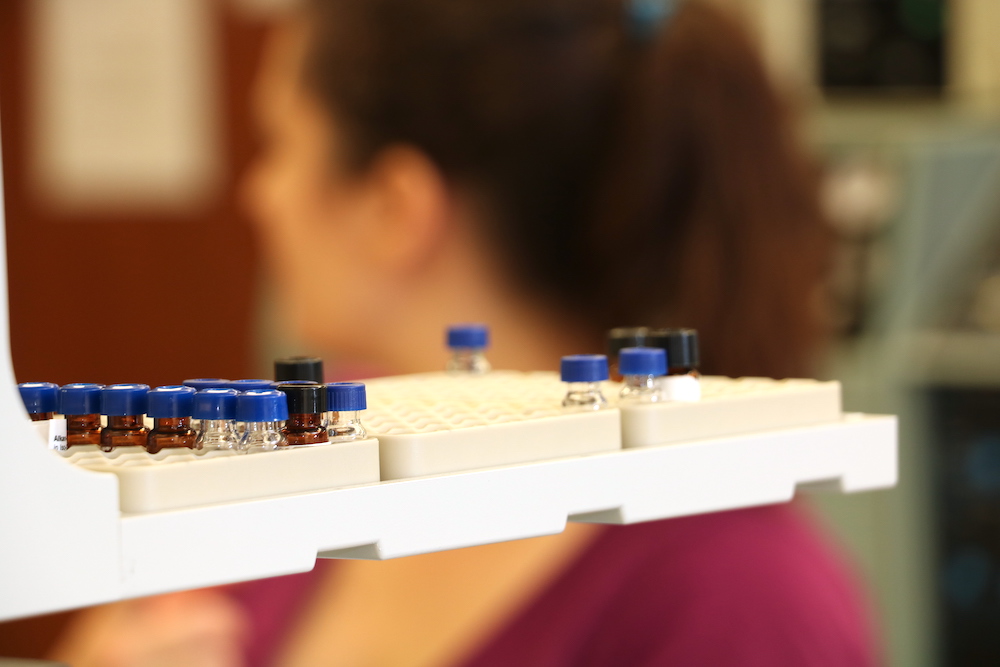Rates, Sample Submission, & Payment Options

Rates
Sample Submission Form
Please complete, print, and enclose a copy of these forms with your samples:
To request set-up as a new SIGF customer, email Carria Collins at carria@tamu.edu and copy e-grossman@tamu.edu. Be sure to specify SIGF in the subject line.
For more information regarding sample shipping, please contact Chris Maupin at crmaupinatx@tamu.edu.
Payment Options
Payment will be due in full after completion of analyses and receipt of data (unless other arrangements are made).
Prepayments can be made under special circumstances.
Electronic Check
Wire Transfer
- If paying via wire transfer, SIGF will need to fax its bank information to you
- Fee for wire transfer: $40.00
Credit Card
- Visa or Mastercard only
- A 3% fee will be added to the amount for credit cards
Departmental Transfer
- Only option for TAMU and TAMU satellite campuses
TAMU Tax ID: 746000531
Shipping Procedure
Please use the following procedure for shipping samples:
Before shipping please fill out the sample submission form. This should be included with a list of samples or a weigh sheet that identifies samples and any corresponding information.
Samples can be shipped to:
Stable Isotope Geosciences Facility
Mailstop 3147
Texas A&M University
College Station, TX 77843 USA
Note that FedEx will deliver to the mail stop, thus, a street address is not required.
Local clients can also hand-deliver samples to Chris Maupin (O&M 405) or the SIGF 4th floor laboratory (O&M 406). Arrangements should be made in advance to ensure that someone is available to receive the samples.
Samples will not be shipped back to you unless requested and you will need to provide us with shipping information for the return. Also, if you request your samples, the cost of returning samples may be added to your final bill or billed separately. We typically hold samples for two months after the analyses are complete in case of any necessary reanalysis.
Solid Sample Analysis for EA-IRMS and TC/EA-IRMS analysis:
Solid samples and oil-based samples for the analysis of C, N, O and H are analyzed using an elemental analyzer (C, N) or pyrolysis (O, H) system interfaced to an IRMS. These measurements include both elemental and isotopic results and require accurate weighing. Minimally, the samples should be sent in clearly labeled vials (glass is preferred to reduce any static effect but plastic vials are also acceptable) and should be dried and homogenized before shipping. We only require a few milligrams of sample (except for soils) so do not send more than 1 gram of an individual sample. There should be enough sample material for reanalysis. The samples should be packed so as to avoid breakage during shipping.
If you prefer to weigh samples beforehand, please contact the facility manager to discuss sample weights. Samples should be prepared into 48 or 96 position well plates and must meet some minimum requirements before analysis. The samples you weigh into tin or silver capsules should be folded/rolled in such a way as not to have any sharp edges that could potentially get stuck in the autosamplers. They should also not have any sample leaking out. Due to sample size requirements, it is imperative to contact the facility manager before starting any of your own weighing. Specific steps need to be taken for the analysis of H from keratin-based samples (hair, feathers, etc.). Contact the lab for details concerning these samples. Any extraction steps (lipids, collagen, cellulose) need to be done prior to shipping.
Solid Sample Analysis for Kiel Carbonate Device:
Solid samples for the analysis of C and O from carbonate are analyzed using the Kiel IV automated carbonate device. Samples must be clearly labeled and sent in glass vials (10-25 ml scintillation vials work best). Samples should be dried and ground to a fine powder. In most cases we will not need more than 300 μg of sample, although if the sample is not 100% carbonate, then send that amount divided by the fraction of carbonate (e.g., 10% carbonate = 0.1). Kiel samples are weighed between 10 and 80 μg.
Liquid Sample Analysis for GasBench and TC/EA analysis:
Liquid samples are analyzed for O, H, N and C.
Provide any necessary description and safety hazards. Minimally you should test the liquids for pH level. We will not analyze any liquids which are too acidic or basic.
GasBench Analysis
Dissolved Inorganic Carbon for δ13C - Water samples should be kept in a cooler and then stored in a refrigerator upon arrival. A minimum of 25 ml is required for analysis but not more than 250 ml. Samples should be analyzed within 1-3 months after collection. Plastic containers are fine, but must be air-tight.
TC/EA Analysis
Pyrolysis method for δD and/or δ18O - requires only microliters of liquid. Send 1-5 ml of sample but no more than 10 ml. There are several vial types that would be suitable for shipping.
Gas Samples for Analysis using GasBench:
Gas samples should be prepared into 12-ml borosilicate exetainer vials available from Labco. These vials attach to 16.5 mm screws cap with septa (color of cap does not matter - except to distinguish between various sets of samples). These vials should be air-tight and sent via ground transportation (high altitudes can sometimes cause the vials to overpressurize and you could potentially lose the samples). If necessary to send via air transportation, expect to lose some samples.
